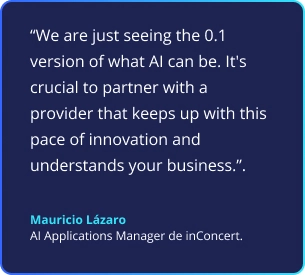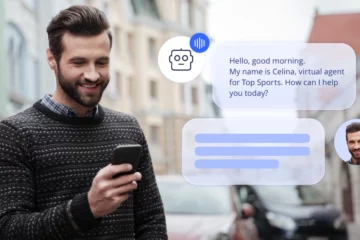An AI-powered bot utilizes machine learning algorithms, contextual analysis, natural language processing , and other methods to automate various tasks or processes related to managing email interactions.
According to Gartner, by 2025, 75% of tasks will be handled by AI . It’s no surprise, then, that this type of bot is already providing real-time assistance to customer service and sales advisors and is one of the AI trends for 2024. Below, we will explain these 3 use cases, how they work, and their potential benefits.
Case 1: Email bot for real-time assistance to service agents
This is an excellent tool for companies that want to start automating their processes but prefer to do it in a more “passive” way. Email automation allows agents to handle a higher volume of cases in less time , which is especially beneficial in high-demand situations.
How does it work?
The agent receives an email in their ticketing system, opens the email, and automatically sees a draft response created by the bot.
The email bot analyzes the case presented by the customer in their text, consults the knowledge base, and based on this, drafts the response. All the agent has to do is review it, edit if necessary, and send it. It’s very accurate; 50% of these drafts don’t need editing, but it provides this option, which is ideal for achieving a human touch in the interaction. It also improves indicators such as resolution time; a process that could take minutes now takes seconds.
The bot also increases customer satisfaction. Besides receiving faster responses, customers notice consistency in the provided answers because predefined guidelines and company policies are followed. This avoids human errors and ensures a consistent experience for customers and they appreciate quick and efficient responses, which can enhance the overall perception of service quality.

Cas3 2: Real-time assistance for scripting compliance
Here, the agent is conducting the sale through a voice call, and the bot plays more of a compliance supervisor role.
How does it work?
The sales executive is making a call, and the bot checks in real-time that the script complies with the mandatory points established by the company. For example, if the sale is for a credit card, it verifies that the interest rate or data privacy is mentioned. If the regulations and policies are not met, the bot can alert the advisor on the screen to comply with them. This bot ensures that all sales calls follow the same guidelines and policies established by the company, contributing to consistency in communication. This is essential for building a strong brand and conveying a consistent product image to the customer.
A key aspect in both use cases is that machine learning algorithms allow these bots to improve over time. As they interact with more cases and receive feedback from agents, they can adjust their responses and recommendations, becoming smarter and more accurate.
Cas3 3: “Ask for Help“, fusionando AI y Expertise Humano
Recently, we have included the “Ask for Help” functionality to our bot, which allows requesting real-time assistance from a supervisor when facing questions that are not in its knowledge base. This collaboration between AI and humans not only improves the accuracy of responses but also facilitates continuous learning for the bot. The supervisor can save the response given, enabling performance improvement over time by enriching the knowledge base it consults.
Knowledge Analytics to boost bot assistance
An AI-powered bot not only executes tasks but also collects valuable data about customer interactions. This data analysis can provide key insights for decision-making, pattern identification, areas of continuous improvement in customer service and sales processes, and staff training.
Efficient management of a customer service bot is a constant challenge that involves ensuring its knowledge base is always up-to-date and covers all user concerns. In this context, our Analytics tool revolutionizes bot maintenance by using artificial intelligence for proactive self-discovery of topics. This innovative feature analyzes unresolved query traffic, identifying patterns and recurring unanswered topics. Instead of investing countless hours in the tedious task of manually reviewing each unanswered question, Knowledge Analytics greatly simplifies this process. It uses advanced semantic summarization techniques to group and prioritize topics based on their relevance, allowing for focused optimization.
In inConcert, we use a combination of various LLMs with specialized training and other knowledge management techniques. An email bot, for example, is just one of the many applications of Generative AI that we currently have. Contact us if you’re interested in exploring AI solutions for your company.



